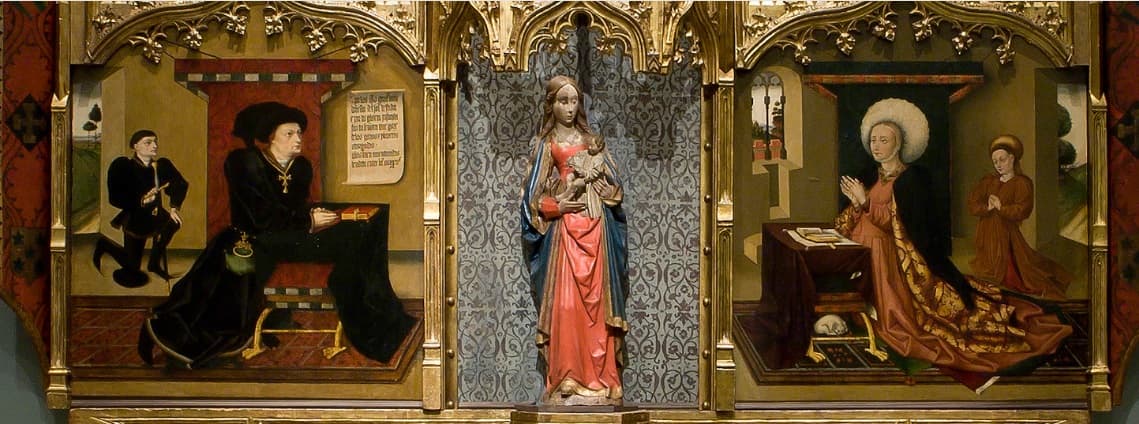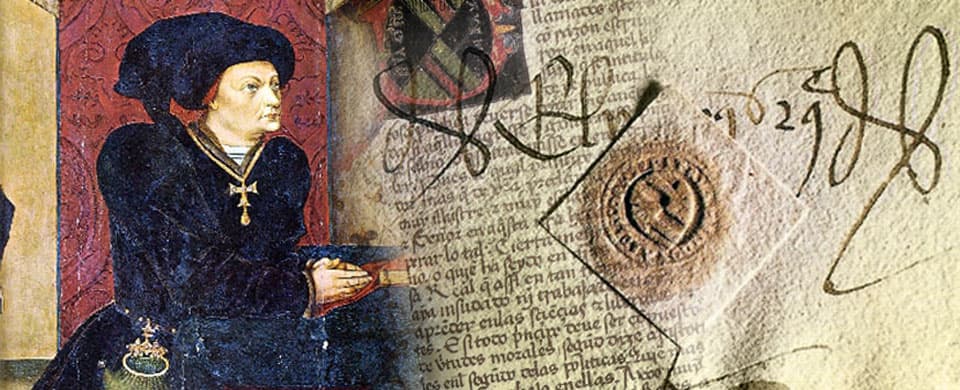A cultural event of the first magnitude visits Madrid: the joint exhibition of the Prado Museum and the National Library entitled ‘The Marquis of Santillana. Images and Letters‘ which can be visited from October 4 to January 8.
Not a long time ago was announced on RTVE without a hint of any mention of the religiosity of this relevant character of the fifteenth century.
The exhibition proposes, for the first time, a joint presentation of a group of paintings and manuscripts commissioned by the Marquis of Santillana, now about 600 years ago, and is complemented by other works by Jorge Inglés –his favorite painter– and a series of codices owned by some contemporary characters who shared the hobbies of the Castilian nobleman.
The television commercial shows the marquis as a introducer of Italian humanism in the Iberian Peninsula, one of the most influential noblemen of the Middle Ages, owner of depositary documents of knowledge such as the ‘General History’ of the Catholic Monarch Alfonso X El Sabio, as well as a promoter of the arts.
The ad, like other media, pays no attention to the spirituality of this important historical figure.
Inigo Lopez de Mendoza and of the Vega (1398-1458), first Marquis of Santillana, 1st Count of Real de Manzanares, 11th Lord of Mendoza, 3rd Lord of Hita and 3rd Lord of Buitrago, was a nobleman, the father of a large family, a sincere Catholic and at the same time a promoter of the arts and sciences.
There is abundant information about him in the Spanish Biographical Dictionary. The currency that he took from his mother’s family was that of AVE MARIA. He trained with an uncle of his, a Catholic priest, whom they called “the archdeacon Guitierre”, who became archbishop of Toledo. One of the sons of the Marquis would be the famous Cardinal Pedro Gonzalez de Mendozaanother undisputed patron of the arts and sciences.
Where do we cut the photo?
The most frequent image of the Marquis is usually incomplete. As usually cropped in books and screens, it seems that he is at a table studying, without further ado. Hang a telltale item from a necklace: a cross.
If we enlarge the image a bit, we see that the Marquis is not at a table studying, but is kneeling on a prie-dieu. Y With a little more zoom backwards, gaining perspective, it turns out that the image is part of an altarpiece, and the Marquis is on his knees praying to the Virgin Mary.

It is the “Altarpiece of the Joys of Santa María”, also called Altar of the Angels or of the Marquis of Santillana. He placed him in the hospital that he had built in Buitrago de Lozoya. It is considered the first documented Castilian Hispano-Flemish painting. His descendant, the 19th Duke of the Infantado, Íñigo de Arteaga y Martín, temporarily deposited it in the Prado Museum, and it is the central piece of this exhibition. It was painted by Juan El Inglés, an expert painter in religious painting who was obviously a practicing Catholic.
On the wall of the enclosure where Don Iñigo prays kneeling, hangs a parchment cartouche with the following verses, which the Marquis himself composed in honor of the Virgin, the Woman dressed as the Sun of the Apocalypse with a crown of twelve stars:
for which joys doze
clothed sun maiden
and for your infinite glory
do it, lady, enjoy
of the joys and pleasures
granted
to the well adventurous
blessed among women.
An important literary work
The Marquis of Santillana was a patron of art. Interested in books, he came to own a library full of illuminated codices (full of paintings), some of them also attributed to Jorge Inglés. Some will be displayed in the exhibition at the National Library. Among them is the famous ‘Book of Alexander’ dedicated to the life of Alexander the Great and written by a thirteenth-century cleric, Juan Lorenzo Segura.
The Marquis also wrote a lot and left us a relevant literary work:
In poetry:
-Minor lyric, of which the Serranillas and the Songs and lyrical sayings stand out.
-Sonnets
-Narrative sayings, among which the Triumph of Love, Hell of lovers and the Comediet of Ponça.
-Moral, political and religious poetry, of which the best known work is possibly the Bias against Fortune.
In prose:
– Moral and political writings, such as the Lamentation of Spaña.
– Literary writings: the Proem or Proem and letter to the constable don Pedro de Portugal
– Exegetical Writings: Glosses on Proverbs.
– Compilations: Sayings that the old women say after the fire.
Precisely in his Proem to the Proverbs (1437) was where the Marquis of Santillana wrote his famous and mentioned phrase: “Science does not dull the iron of the spear nor does it weaken the sword in the hand of the knight.”
The faith of Jorge Inglés, one of the great painters of the 15th century
Jorge Inglés, the painter of the altarpiece that we have commented on, is considered to be the introducer of Flemish painting in Spain. His fervent religiosity is evident both in the commissions he carried out and in those who commissioned them, nobles and ecclesiastics. He is considered one of the most splendid painters of the fifteenth century in Castile.
Other of his works are: the Altarpiece of the Virgin in the parish of Villasandino, in Burgos, the attribution of a Trinity in the Prado Museum, a Preaching, preserved on panel in the Cincinatti Museum of Art, and the Altarpiece of Saint Jerónimo in the National Sculpture Museum of Valladolid.
It has been pointed out that Jorge Inglés would have been trained in Spain, in a strong tradition of miniaturists. In fact, many of the books that made up the library of Íñigo López de Mendoza are decorated with beautiful miniatures that undoubtedly come from the hand and inspiration of master Jorge, books like Tcavalry ratate of Bruni d’Arezzo, of the Great and General History and General Chronicle of Alfonso X the Wise which will be displayed at the exhibition.
The exhibition is more than recommendable, although it does not clearly show its Catholic roots. Anyone who wants can emulate the Marquis of Santillana: get on your knees and pray to the Virgin to have the wisdom that she had.
In the 1980s, Radio Televisión Española presented the Marquis of Santillana in this way, but not Íñigo, the first, the one in our article, but Diego, the second.
The Marquis of Santillana, the promoter of science and arts kneeling before the Virgin Mary

